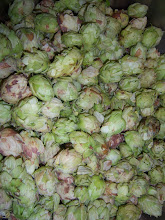 dined on lobster rolls, wood-fired pizzas, and buffalo jerky. Jenn also went with the grilled cheese. Oh, and I can’t forget the porchetta sandwich. Must remember that.
dined on lobster rolls, wood-fired pizzas, and buffalo jerky. Jenn also went with the grilled cheese. Oh, and I can’t forget the porchetta sandwich. Must remember that. After our self-inflicted food comas, we retired a while to recuperate. And since I had brought along several deuce-deuces of my fine homebrew products to sample (after all, who doesn’t travel with beer?), we decided to pull out the Huckleberry Honey Wheat beer I brewed a little over 2 ½ years ago. Ah, aged beer. It’s been over a year since I sampled any of this batch, and that year has been very very good to this beer. Let’s just say that I’m sad this beer is on the verge of extinction. Crisp, tart, dry, and the oxidation that has developed works well with the huckleberry flavors. I need to remember to score myself some more of that huckleberry honey next time I am out west. Scoring pounds of fresh huckleberries is gonna a tad more difficult...
12: Huckleberry Honey Wheat
Mini-mash:
8 oz. Rahr 2-row Pale
4 oz. Durst wheat
8 oz. Dingeman’s Biscuit
8 oz. Weyerman Pale
8 oz. Maris Otter
Mashed @ 150° F for 45 minutes
Sparged with 1 gallon of 170° F water
Added fluid to brew kettle, brought to a boil (60 minute) and added:
4 lbs. Alexander Wheat Malt
2 ¼ lbs. Huckleberry Honey
8 oz. Belgian candy
1 oz. German Hallertau pellet
w/10 min. to go:
1 oz. German Hallertau pellet
1 tsp. Irish Moss
Cooled wort, racked to bucket, and pitched Wyeast 3942 Belgian Wheat
Brewed: 9/28/2007
Secondary w/fruit: 10/6/2007; added 3 lbs. frozen and crushed huckleberries
Secondary: 10/26/07; @ 1.009
 Bottled: 11/04/2007
Bottled: 11/04/2007
OG: 1.050
FG: 1.008
Mini-mash:
8 oz. Rahr 2-row Pale
4 oz. Durst wheat
8 oz. Dingeman’s Biscuit
8 oz. Weyerman Pale

8 oz. Maris Otter
Mashed @ 150° F for 45 minutes
Sparged with 1 gallon of 170° F water
Added fluid to brew kettle, brought to a boil (60 minute) and added:
4 lbs. Alexander Wheat Malt
2 ¼ lbs. Huckleberry Honey
8 oz. Belgian candy
1 oz. German Hallertau pellet
w/10 min. to go:
1 oz. German Hallertau pellet
1 tsp. Irish Moss
Cooled wort, racked to bucket, and pitched Wyeast 3942 Belgian Wheat
Brewed: 9/28/2007
Secondary w/fruit: 10/6/2007; added 3 lbs. frozen and crushed huckleberries
Secondary: 10/26/07; @ 1.009
 Bottled: 11/04/2007
Bottled: 11/04/2007OG: 1.050
FG: 1.008
Saison d’Erpe-Mere...
So if all of this wasn’t enough, we headed off to Prime Meats in Brooklyn for dinner. Nothing like a dozen oysters, steak tartare, and a wild mushroom risotto. Plus, they had de Glazen Toren Saison d’Erpe-Mere on tap. That’ll round out dinner just about perfect. Dee-licious. Oh, and Brouwerij de Glazen Toren is in Erpe-Mere, Belgium. Belgium is to saison like beer is to tasty. Saison d’Erpe-Mere has a spicy bubble-gum ester nose. While it was delicious across the board, I recall the nose. That, and I’m still not taking notes. Suck it up and deal.
 From the Brouwerij de Glazen Toren website: “Bitter in the nose like citrus, dry and sweet bitter in the mouth, long gradually spreading bitter aftertaste.”
From the Brouwerij de Glazen Toren website: “Bitter in the nose like citrus, dry and sweet bitter in the mouth, long gradually spreading bitter aftertaste.”ABV: 6.9%
The wild kingdom took a hit today, what with all the various creatures we ate. Alas, my hedonistic run is about to be closed.
And where o’ where is the fish-ball man? My visit to Clinton Hill is not complete without your delicious repast, oh fish-ball man...
(7/31/2010)















































